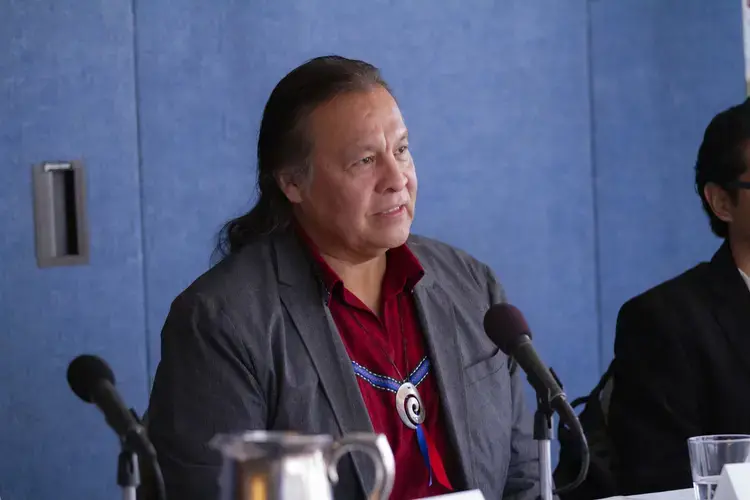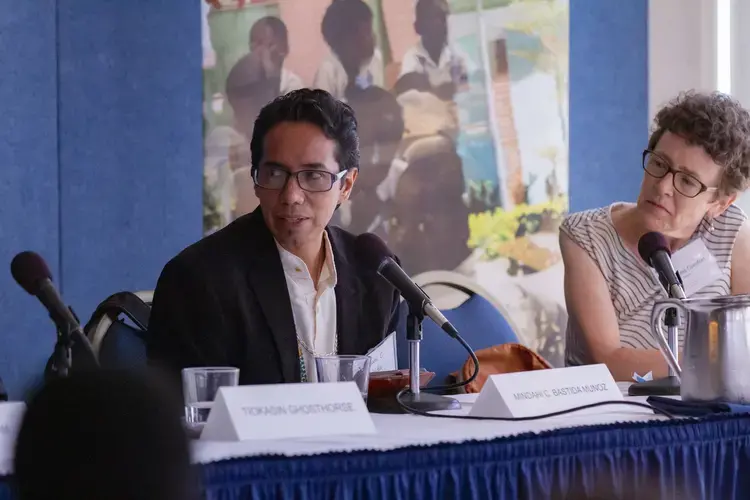
Moderator Mary Evelyn Tucker, co-director of the Forum on Religion and Ecology at Yale University, opened up the Religion and the Environment panel saying that those with a spiritual perspective of Mother Earth, water, and life electrify people around their work.
"This panel will highlight the significance of Indigenous peoples, native peoples, First Nations peoples, in holding that fire alive… That fire, being recovered now by many cultures around the world, is something we celebrate, but those peoples who are at risk for their beliefs and practices, traditional, environmental knowledge, who are criminalized around the world, in different parts of the world, are people who must be supported by other religions, journalists, and by NGO groups.”
In more recent years, we as a global community have slowly been coming to the conclusion that we must conserve the Earth. Change is necessary, but what sort of change are we supposed to make?
Panelists explored how spirituality and the environment should go hand-in-hand and how we must embrace this knowledge if we are to make major changes. Could the key to protecting and saving our environment be through religion and spirituality?
Kalyanee Mam, a filmmaker, lawyer, and storyteller, spoke to us about her moving experience with the people of Areng Valley in Cambodia. Mam, a Pulitzer Center grantee, created a short documentary, "Fight for Areng Valley," centered around the Chong people of Areng Valley who were in danger of being flooded by the construction of a new dam. Help in a rural area to stand to the Cambodian government is not readily available. Aided by a group of monks, the Chong people were able to put a stop to the dam construction.
Mam was touched by the determination and strength of the people: “It was the people who were living with the land who had a spiritual connection. . . . The people are the ones who had the knowledge, the wisdom, the connection to the land that we had to listen to.” Anyone who wants to help has to know that “it is important to listen to the wisdom of the people, who actually live with the land, who have this understanding of time and space and connection that is much more profound than how we see the world today.”
They are fighting not only for themselves or for their current living situation, but they are also thinking about life on a much bigger and grander scale. They say that “we need to protect the land of our ancestors,” and stress how important their land is to their descendants and to the life around them. “Our lives would not be possible if it was not for our ancestors, the trees, plants, and animals, that grant us our lives as they are. We have to listen to the people who live with the land and they have a connection that is much more profound."

Time and time again, we think about the earth and about what needs to be done, but that type of thinking is our problem. We think of the Earth as a separate entity. Tiokasin Ghosthorse is a speaker on peace, Indigenous, and Mother Earth perspectives, a member of the Cheyenne River Lakota Nation of South Dakota, and a 2016 Nobel Peace Prize nominee. He made the important point that we think about the Earth, not with it.
If we can embrace a new mode of language that does not allow exclusion, if we go beyond religion and dominant thinking, Ghosthorse is adamant that we will be able to understand what needs to be done to best help Mother Earth and the environment. “The language is always about being focused, about being conscientiously alive, and awake, of every second.”
“Mother Earth has the answer, we just have to listen.” Ghosthorse said. If we can take hold of this new language, then our efforts for the environment will have better results than what a temporary grassroots mentality can offer. We need to get rid of the domination state of mind. Ghosthorse adds, “Before I came here, I asked the Earth, what do you want me to say, Mother, because no one is listening anymore.”

Reunification is a key element that is needed to protect and save the environment. “It’s about remembering, and remembering is coming together,” said Mindahi C. Bastida Muñoz, director of Original Caretakers Program at the Center for Earth Ethics.
He spoke to us about our roles as the environment’s caregivers. “This unification process is about remembering what kind of creatures we are as human beings” and that “our mission as human beings is to be here for life, to take care of life.”
Ultimately, Bastida Muñoz asks the question, “If you are not caring for life, then what are you doing?” Bastida Muñoz does not hold back and holds us, as human beings, accountable for our decisions and our actions. We denied our responsibility to take care of our environment, leaving us in our current state of urgency, where we are simply trying to gather efforts to conserve.
Indigenous people take on their role as caretakers very seriously, striving to maintain and grow that sacred connection with Earth. Traditional religions have been stripped away over the years, but those religions can never be fully diminished. Bastida Muñoz declares that the religion of Indigenous people is the environment, “taking care of life.”
“Eighty percent of the biodiversity in this world is found in Indigenous people’s territories. This is not an accident. We don’t take it for granted. It’s a lot of hard work to care for,” said Bastida Muñoz.
Ghosthorse and Bastida Muñoz pointed out that our society values the Indigenous peoples of the Earth for the wrong reasons when it comes to preserving the environment. Our views on Indigenous people are biased. Our societies tend to greatly romanticize them, believing that they have all the necessary knowledge on how to conserve our environments. That romanticization takes us into the mindset where the extent of our environmental efforts ends with the passing of the torch to Indigneous people.
Bastida Muñoz said that in this way, “we are no better than where we were in 1922." Ghosthorse pointed out, "Indigenous people have the smallest carbon footprint, but are the ones most affected by climate change.”
Both Ghosthorse and Bastida Muñoz want us to come together with Indigenous people and build strong efforts and strategies for the sake of our Mother Earth.
As Bastida Muñoz said, “Hope is a poisonous candy. Hope is not enough. We need to take action.”
He also adds that we are not the top of all creation, but in all honesty, we are the youngest. The truth is that the Earth “is not a resource. It is made up of sacred elements and must be treated that way.” Bastida Muñoz does not dance around the truth. “The problem is us, and we have to resolve that problem.”
"Climate change is not just a technical problem, but a spiritual problem... When we're looking at solutions for climate change, we need to be attentive that we're not repeating mistakes... & impacting people who live on the land" @ComfortIJT #PulitzerBeyondReligion
— Nora ML (@noradml17) June 8, 2019
Marianne Comfort, the justice coordinator for Earth, Anti-Racism, and Women, Sisters of Mercy of the Americas, discussed a new initiative by the pope and Catholic Church to work with Indigenous people for environmental efforts.
Four years ago, Pope Francis released the Laudato si'. Despite the fact that many believe it to be centered on climate change, she said, it is more of a "teaching document" highlighting the importance of listening to "the cry of the earth and the cry of the poor."
The Laudato si' states that we cannot approach one or the other without integration. The Pope calls for an “ecological conversion” so that we are more in tune with the Earth, improving our living and harmony with it. Recently, cardinals and Indigenous leaders from all over the world came together to see how the Catholic Church can be better serve, lift up the realities of, and speak for the people.
The Sisters of Mercy of the Americas actively engage with communities to examine the environmental impacts people are facing because of extractive industries. The Sisters strive to hear firsthand the situations people are facing. Those who live on the land, who are fighting and protesting for its conservation, are often criminalized for their actions and there is no compensation when their land is taken away from them.
In October 2019, the Catholic Church will hold an Amazonian Synod that will give the Indigenous people the opportunity to voice their opinions and state their realities to the Pope. The Catholic Church is making strong efforts to listen to the voices of the people who are involved for any future environmental approaches.
Each of the panelists brought treasured wisdom, along with passion and insight on how we as human beings should be approaching our environment.
Tucker reminded us that the Earth Charter from the year 2000 is finally gaining traction around the world. And the Universal Declaration for the Rights of Mother Earth and the Peoples Agreement was the remarkable result of over 30,000 people gathering in Cochabamba, Bolivia, for the 2010 World People's Conference on Climate Change and the Rights of Mother Earth. It was the first time that the views of the Indigenous people themselves were written down and documented. These are the types of inclusive efforts that we need for the future of our world.








